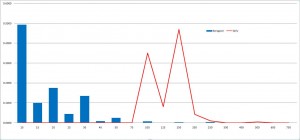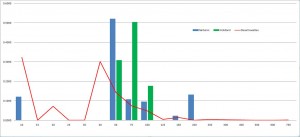Outliers
For those that joined us late, yesterday I looked at a bunch of Kickstarter projects related to webcomics and drew some conclusions that seemed to hold pretty true for a wide variety of cases. But I kept coming back to two sets of numbers. The first being the listing of all contributors in various tiers across all 39 projects:
… and the second being that same graph, with the most obvious fringe cases removed:
Removed because the sheer number of contributors to just four projects (Order of the Stick, Poorcraft, Diesel Sweeties, and Borogove) really skewed the results. Without those four projects, the others produced a tolerably flat distribution up to the US$100 tier, then a second one up to US$250; past that, the counts were negligible.
But these projects weren’t necessarily unusual just for their supporter counts (the 14,952 OoTS supporters accounted for more than 37% of all backers in all projects; the other projects had support counts¹ that were matched or exceeded by other projects not called out), but for their lumpiness. In fact, there were other projects that were lumpy in interesting ways, but tended to balance each other out and disguise that fact. It’s the lumpies that we’re looking at today.
In addition to three of the four already cited (I’m omitting OoTS from call-out analysis because there’s just too much there — too many microtiers, too many limited rewards, too many add-ons … I suspect some B-school wannabe could write a thesis on just that one campaign), we’ll be examining how Girly, Narbonic, Kickstand Comics, Schlock Mercenary, Modest Medusa 1², and Smut Peddler are atypical, yet found niches to exploit. The usual warning that your mileage may vary applies double to these case studies.
First up, a pair of projects that have opposite tendencies in dollar figures: Borogove had 1500+ backers, and operated predominantly at low dollar figures; Girly had about 200 backers, with the lowest reward tier at US$100:
Quick side note: because details would be lost comparing two projects where the backer counts differ by a factor of five, I’ve translated this and the remainder of charts into percentages; the 740+ backers at US$10 or less for Borogove equals just under 50% of all backers for that project. Likewise, the 74 and 99 backers at the US$100 and US$150 levels (respectively) equate to 35% and 47% (respectively) of all backers of Girly — we can see how the relative counts stack up without Girly being too small in the vertical dimension to appreciate.
How did Girly succeed with only high-dollar value donors? The base reward was a multi-volume, slipcased book set with a built-up demand. Low count, very high margins per item. Borogove, by contrast, was a card game (cheap to produce) that was tangentially referenced in Kory Bing’s Skin Deep. Essentially cheap enough to be an impulse buy, one has to hope that the few dollars to be made after cost of producing the decks didn’t get entirely consumed by shipping and the efforts of shipping. This was probably a break-even proposition at best.
Next up: Poorcraft and Schlock Mercenary: The Board Game.
I chose these two not only for their obvious contrast in distribution, but because both managed to absolutely dominate in just one reward tier (nearly 80% penetration), at opposite ends of the spectrum. 877 out of 1111 people took the lowest pledge that would get them a copy of the boardgame, and 495 out of 793 people took the lowest pledge that would get them a copy of Poorcraft (plus another 51 in the same statistical grouping that would have gotten a PDF instead of a physical copy).
Ironically, the much higher-priced SM: The Board Game might not actually work as a high-margin item, as it’s a fairly complex production with lots of parts and fiddly bits³ requiring assembly and many bonus content doodads. Poorcraft, by contrast, had most of its rewards related to nothing more complex than the number of copies that went into the envelope, with higher value rewards attached to essentially free items — credits in the book, appearances in the book, original pages (already paid for). If the books could be gotten in quantity sufficiently cheaply (and finding good value for money is the theme of Poorcraft, after all), the ROI might actually be better than for SM:TBG.
Similar breakdown with Modest Medusa 1 and Smut Peddler:
The US$15 tier at SP gets you a PDF of the book, and the US$30 tier gets you a paperback; the 2291 backers made those two reward tiers account for an unreal 88.3% of all pledges. The near-zero cost of distributing PDF (compared to mailing) and the higher income per copy of SP (by a factor of three vs. Poorcraft) means a whole lot more free cash rolling around in Spike’s pockets, which she famously paid out to her artists — US$700 per creator or creator team. As a spread-the-wealth project, this was a resounding success, one that couldn’t have worked at lower pricepoints.
Modest Medusa saw a pretty impressive spike at the base-get-a-book level (70%), which makes it a perfectly cromulent use of Kickstarter to accomplish a particular project. Given the relatively low backer count (274), the excess funds aren’t enough to be self-sustaining going forward to the next project (cf: footnotes, where we note that MM2 is currently raising funds).
Last up, a contrast between relatively few reward tiers and a lot of reward tiers all over the damn place: Narbonic, Kickstand Comics, and Diesel Sweeties.
The first two have, respectively, 6 and 4 reward tiers (two of which were combined into one by the data grouping in the case of KC), each featuring a relatively high price point (US$50) to get something tangible (the US$10 tier for Narbonic gets you a PDF). They’re also both giving fairly large rewards — six years of comics in the case of Narbonic (with higher reward tiers giving tangible and desirable value-adds in the form of hardcovers and handtooled slipcases), and three books totaling more than 1000 strips in the case of Kickstand. The only differences between the Kickstand rewards were foreign (higher shipping costs) vs domestic, sketched vs unsketched; the relative paucity of bike-themed comics probably worked in Rick Smith’s favor, particularly given the prominence of cycling culture abroad (a full 29% of his 660 orders were international, which is probably a record).
Rich Stevens, by contrast, is able to treat the one third of backers in the cheap seats as free money — he had to put in the effort of making an e-book out of 3000 comics to satisfy the higher-tier rewards, and they get to download work he did anyway; that’s 490 people times 10 bucks (actually 8, since he did almost all his pricing in 8-bit multiples) times no fulfillment costs. As noted in earlier analyses, that’s the only way to not go broke with so many backers getting something for so little money.
The spike at the US$40 range (actually 32) represents the minimum to get a tangible reward (a USB drive with the e-book on it). The real costs to Stevens are the time/effort to produce the book; the drives themselves can probably be had very cheaply in the quantities Stevens is looking at (458 in this tier, plus everybody at higher tiers, for most of 1000 people — and you can find USB drives of similar case complexity for 8 bucks retail), and the damn things are made of rubber so they don’t need protective shipping. One caveat: Rich Stevens is a mad genius who regards sleep as the enemy; unless you emulate that, you will go crazy trying to work things like he does.
Tomorrow: Nothing about Kickstarter or I may kill myself.
_______________
¹ Poorcraft: 703; Sweeties: 1520; Borogove: 1507.
² I probably should have noted yesterday that Modest Medusa volume 2 is likely to outstrip volume 1, but still has two and a half weeks to go.
³ Not that my evil twin would have it any other way — fiddly bits are a way of life for him.






The whole reason we took SMTBG, aka “Schlock Mercenary: Capital Offensive” to Kickstarter was that the ROI was low, so you’re absolutely right in that regard.
Also, thank you for doing this breakdown. This is the most comprehensive look at Kickstarter that I’ve seen to date. The one thing that’s missing (and it’s critical) is a pass through the “graveyard” (term lifted from Nassim Taleb’s work), which is to say, somebody needs to analyze projects that fail, and grind on some of the same criteria you’re grinding on here.
By Howard Tayler on 06.12.12 5:17 pm
For Gary’s set of 39 funded projects plus 20 “graveyard” projects* there
is a pretty decent linear correlation between total backers and amount
pledged (with a slope of ~$50/backer). In contrast, there is no correlation
between goal and amount pledged. Surprisingly (?), there is a clean break
between the funded and unfunded projects at 100 backers. Does anyone know
of any unsuccessful comics Kickstarters with more than 100 backers?
*(unsuccessful comic book or anthology projects with more than 1 backer;
collected by searching for “comics” on Kickstarter and working back from
the last page of results and stopping at the first page of funded projects,
skipping results for comics-related videos, stand-up comics, etc.)
By Mark V on 06.13.12 2:39 am
Board Game publishing is a very low return on investment project / business. For Schlock Mercenary, this is a board game of almost 300 tokens and thus a decently hefty manufacturing price tag. A general guideline for publishing in the board game universe is an x6 – x10 retail cost based on manufacturing.
A lot of board game publishing is done for the love of publishing and providing entertainment. I am blessed enough to have had the chance to work on the Schlock Mercenary board game with Howard and hope to continue to provide entertainment related to the game for years to come.
By Nicholas Vitek on 06.29.12 6:19 pm
The above comments are owned by whoever posted them. The staff of Fleen are not responsible for them in any way.